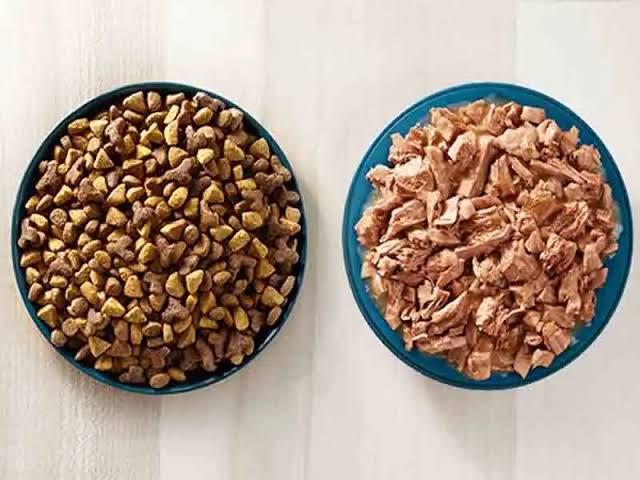
Wet Food vs. Dry Food: Which Is Best?
Deciding between wet and dry pet food isn’t always simple. Each option has unique benefits and drawbacks, from hydration and palatability to cost and convenience. This comprehensive guide explores their nutritional differences, health impacts, and suitability for various pet needs—helping you make the best dietary choice for your dog or cat’s long-term health and happiness.
🐶 Pet Star
51 min read · 2, Jul 2025

Introduction
Pet owners are often faced with the critical decision of what type of food to feed their furry companions. One of the most debated topics in pet nutrition is the comparison between wet food (also called canned food) and dry food (commonly known as kibble). Both have their advocates, and both come with advantages and disadvantages. This article will explore wet food vs. dry food in detail, focusing on factors like nutritional content, health benefits, dental implications, cost, convenience, and more—giving you a well-rounded perspective to choose the best option for your dog or cat.
1. Nutritional Content: The Core of the Debate
Wet Food
Wet food generally contains more moisture (70–85%), which is especially beneficial for pets who do not drink enough water. It's typically higher in protein and lower in carbohydrates, making it closer to a carnivorous animal's natural diet. It may also contain fewer artificial preservatives, as the canning process itself is a form of preservation.
- Advantages:
- High moisture content prevents dehydration and supports kidney health.
- Richer taste and smell, appealing to picky eaters.
- Often higher in animal protein and lower in carbs.
- Disadvantages:
- Shorter shelf life once opened.
- Can be more expensive per serving.
- Prone to spoilage if left out for too long.
Dry Food
Dry food, or kibble, typically contains 10% moisture and a higher proportion of carbohydrates due to the processing methods. While this may not resemble a natural diet as closely, many kibble formulations are nutritionally complete, fortified with vitamins and minerals.
- Advantages:
- Convenient and easy to store.
- More affordable in the long run.
- Better for free-feeding pets.
- May promote dental health (though this is debated).
- Disadvantages:
- Low moisture content may lead to dehydration.
- Often contains fillers and artificial preservatives.
- Less appealing to finicky eaters.
2. Health Impacts: What Does the Science Say?
Hydration and Kidney Health
Cats, in particular, are prone to urinary tract issues and kidney disease. Wet food’s high moisture content helps flush toxins from the kidneys and keeps the urinary tract healthy. Dogs can benefit from this too, especially in hot climates or if they are prone to dehydration.
Dental Health
Dry food is often praised for its ability to scrape tartar off teeth. However, most vets agree that the dental benefits of dry food are minimal. Regular brushing and professional cleanings are far more effective. Some prescription kibbles are specially designed to support dental health.
Obesity and Weight Management
Dry food is often denser in calories, meaning pets can easily overeat, especially if free-fed. Wet food, with its higher water content and lower caloric density, may promote satiety and help with weight control.
Digestive Health
Wet food is generally easier to chew and digest, which is advantageous for older pets or those with dental issues. Dry food, while harder, can be good for pets with healthy teeth and strong jaws, promoting natural chewing behavior.
3. Cost Considerations
Wet Food
- Typically more expensive per calorie.
- Not ideal for feeding large breeds or multiple pets unless budget permits.
- Generates more packaging waste due to individual cans or pouches.
Dry Food
- Cost-effective and sold in bulk.
- Less expensive per meal and per day.
- Can be stored for longer periods without spoiling.
4. Convenience and Storage
Dry food wins in terms of convenience. It can be left out all day, is easy to measure, and doesn’t spoil quickly. Wet food, while more appealing, needs refrigeration after opening, and uneaten portions must be discarded quickly to avoid bacterial growth.
5. Picky Eaters and Palatability
Wet food almost always wins here. Its strong aroma and soft texture make it highly palatable. Pets recovering from illness or those with reduced appetites may respond better to wet food.
6. Mixed Feeding: The Best of Both Worlds?
Many veterinarians now recommend a mixed feeding approach—providing both wet and dry food to leverage the benefits of both. For example:
- Morning: Wet food to encourage hydration and provide a protein-rich start.
- Evening: Dry food to promote chewing and keep the pet feeling full overnight.
This approach allows for dietary variety, reduces monotony, and ensures a more complete nutritional profile.
7. Age, Breed, and Health-Specific Needs
Different pets have different needs. Here’s a quick reference:
Pet Profile Best Choice Senior Pets Wet food for easier chewing Puppies/Kittens Wet food or combination Overweight Pets Wet food to reduce calorie intake Large Dogs Dry food for affordability Dental Issues Wet food or softened kibble Healthy Adults Either or both 8. Environmental and Ethical Considerations
Dry food tends to have a smaller carbon footprint due to less packaging and more efficient production. Wet food often comes in single-use aluminum cans or plastic pouches, increasing environmental waste.
For environmentally-conscious pet owners, some dry food brands now offer eco-friendly packaging or use sustainable protein sources like insects or plant-based proteins.
9. Veterinary Perspectives and Pet Preferences
Most vets agree that the best food is the one that suits your pet’s health, lifestyle, and preferences. While some pets thrive on dry kibble, others may require wet food due to medical issues or dietary sensitivities. Always consult your veterinarian before making major changes to your pet’s diet.
Choosing between wet and dry food for your pet is a complex and nuanced decision that depends on multiple factors including nutrition, cost, convenience, health benefits, and your pet’s unique preferences and physiological needs. Wet food, also known as canned food, is characterized by its high moisture content—typically 70% to 85%—which makes it an excellent choice for pets who don’t drink sufficient water on their own, especially cats who are notorious for low thirst drives and dogs with specific health concerns such as kidney or urinary tract issues. This high water content helps keep pets hydrated, promotes kidney function, and can prevent or mitigate conditions like urinary crystals or chronic kidney disease. Furthermore, wet food is generally more palatable, thanks to its rich aroma and soft texture, making it ideal for picky eaters, pets with dental problems, or senior animals with diminished senses or difficulty chewing. The composition of wet food tends to include higher-quality animal proteins and fewer carbohydrates, often aligning better with the natural diet of carnivorous pets. This can be particularly beneficial for pets with sensitivities to fillers, grains, or gluten commonly found in commercial dry kibble. However, despite its health advantages, wet food is not without drawbacks: it is more expensive per serving, less eco-friendly due to single-use packaging, prone to bacterial spoilage if left out, and requires refrigeration after opening. On the other hand, dry food, or kibble, is convenient, shelf-stable, economical, and often easier for pet owners to store, serve, and portion accurately. It’s particularly suitable for busy households, large dogs, or multi-pet families where feeding logistics and cost efficiency are a concern. While dry food may not provide the same level of moisture or protein density as wet food, it is still widely accepted as nutritionally complete if made by reputable brands and properly balanced with necessary vitamins and minerals. Some pet owners also believe dry kibble aids in dental health by scraping plaque off teeth during chewing, although most veterinarians agree that this benefit is minimal and not a substitute for brushing or professional cleanings. One of the main concerns with dry food is its tendency to contain higher levels of carbohydrates and additives such as artificial colors or preservatives, which may contribute to obesity or food sensitivities over time, particularly when pets are free-fed or inactive. In contrast, wet food can support weight management by offering lower caloric density and increasing feelings of fullness. When considering health impacts more broadly, it’s clear that individual needs vary greatly: for instance, senior pets or those with gastrointestinal sensitivities might thrive on soft, easily digestible wet food, while active or working dogs may benefit from the higher energy density of dry kibble. From a financial perspective, dry food is more affordable on a per-calorie basis, available in bulk, and involves less packaging waste, making it more sustainable and practical for long-term use. But those willing to invest in premium wet food often do so for its superior taste and health benefits, especially during recovery from illness or surgery. As for feeding strategies, some veterinarians and pet nutritionists recommend a hybrid or mixed approach—feeding wet food in one meal and dry in another—to combine hydration and palatability with convenience and cost-effectiveness. This mixed method allows pets to enjoy the benefits of both textures and flavors, reduces mealtime boredom, and ensures a broader spectrum of nutrients. It's also crucial to remember that dietary needs differ based on breed, age, activity level, and health condition. For example, kittens and puppies require high-protein, energy-dense food to support growth, while adult pets may need a more balanced profile, and seniors often benefit from joint-supporting additives and softer textures. Pets with allergies or chronic conditions may also require specialized veterinary diets available in either format. Environmentally, dry food generally has a lower carbon footprint and uses less packaging, although this is changing as more sustainable wet food brands enter the market with recyclable cans and ethically sourced ingredients. Despite these considerations, the pet food industry continues to evolve with innovation in both dry and wet formats, such as freeze-dried raw options, grain-free recipes, novel proteins like insects or fish, and functional foods enriched with probiotics, omega-3s, or glucosamine. Ultimately, the best food is not defined by format alone but by how well it supports your pet’s overall health, meets their individual nutritional requirements, and fits your lifestyle and budget. While some pets may thrive exclusively on kibble or canned food, others might benefit from a thoughtfully combined approach, and the key to success lies in consistency, portion control, and regular monitoring of your pet’s weight, energy, coat condition, and stool quality. Regular veterinary checkups are also essential to ensure your feeding strategy continues to meet your pet’s evolving needs, especially during life stage transitions such as aging, pregnancy, or after surgical procedures. Introducing new food should always be done gradually—over 7 to 10 days—to avoid digestive upset, and observing how your pet reacts is crucial to determining long-term suitability. Pet owners should also read ingredient labels carefully and prioritize whole, recognizable ingredients over by-products and artificial fillers. In conclusion, there is no one-size-fits-all answer to whether wet or dry food is best—it’s about aligning food choices with your pet’s health goals, personal preferences, and practical realities. Whether you lean toward the rich, hydrating profile of wet food or the convenient, long-lasting nature of dry kibble, or even choose to feed both, what truly matters is providing a complete, balanced, and species-appropriate diet that enhances your pet’s quality of life for years to come.
Pet owners often have a range of questions when deciding between wet and dry food for their pets, and understanding the nuances behind each can help in making informed choices tailored to your pet’s specific needs and lifestyle. One of the most frequent questions is, “Is wet food more nutritious than dry food?”, and the answer is that both can be nutritionally complete if formulated properly, but wet food typically contains more moisture and often more high-quality animal protein, which is especially beneficial for cats and dogs that require higher hydration or are recovering from illness. Another concern is, “Does dry food really clean my pet’s teeth?”, and while some kibble is marketed as beneficial for dental hygiene, most veterinarians agree that its effect on plaque and tartar is minimal at best, and that proper dental care including brushing, dental treats, and occasional vet cleanings is more effective for maintaining oral health. “Can I mix wet and dry food together?” is a popular question as well, and yes, you can absolutely mix the two, which many vets recommend as it offers the benefits of both: the hydration and palatability of wet food with the convenience and affordability of dry food, though it's important to balance calories to avoid overfeeding. For owners concerned about weight, the question often arises, “Which type of food is better for overweight pets?”, and wet food may be the better option in such cases because it’s less calorie-dense per gram due to its water content, which means pets feel fuller on fewer calories—although dry food formulations labeled “weight control” or “light” are also available. Regarding financials, “Is dry food more cost-effective?” is commonly asked, and the answer is yes, in most cases dry food is significantly cheaper per serving and per calorie than wet food, making it ideal for households with large dogs or multiple pets. From a storage standpoint, “Which type of food lasts longer?” is often asked, and dry food wins here due to its long shelf life and resistance to spoilage, whereas wet food must be used quickly once opened and refrigerated to prevent bacterial growth. Pet parents with senior pets or those with health issues often wonder, “Is wet food better for older animals?”, and the answer is yes—it’s softer, easier to chew and digest, and usually more appealing to pets with diminishing senses of taste or smell, making it ideal for seniors or those recovering from surgery or illness. “Is one better for hydration?” is another major concern, especially with cats, and wet food is clearly superior in this regard, as its high moisture content helps maintain kidney health and prevents urinary tract issues, while dry food may require owners to actively monitor and encourage water intake. Many new pet owners also ask, “Can I switch between the two types of food?”, and yes, switching is possible but must be done gradually over 7–10 days by mixing small amounts of the new food into the old to avoid digestive upset, loose stools, or food rejection. Another vital consideration is, “Do both types offer complete nutrition?”, and the answer is yes—as long as the food is labeled “complete and balanced” by AAFCO or similar regulatory bodies, it meets the minimum dietary requirements for pets, though ingredient quality may vary. When it comes to breed and size-specific needs, “Do large and small pets have different food needs?”, the answer is yes: large dogs might do better on dry food due to higher caloric demands and cost efficiency, whereas small breeds or cats may prefer the soft, easily chewable nature of wet food. Health-conscious owners often ask, “Is wet food better for pets with allergies or food sensitivities?”, and generally, yes—wet food usually contains fewer fillers, preservatives, and allergens such as corn, soy, or wheat, making it a better choice for sensitive pets, though hypoallergenic dry food options do exist. A common concern from environmentally conscious pet owners is, “Which food has less environmental impact?”, and dry food typically has a smaller carbon footprint and uses less packaging, though sustainable brands are emerging in the wet food category using recyclable materials and ethically sourced ingredients. Another important question is, “Are there any risks with feeding only one type of food long-term?”, and the answer is that while it’s possible to feed just wet or dry food if it’s nutritionally complete, some experts argue that pets benefit from dietary variety to prevent boredom and promote overall health. From a behavior standpoint, “Does food texture affect pet behavior or mood?”, and the answer is yes—some pets become bored with dry kibble and may show more excitement or appetite stimulation with the soft, aromatic nature of wet food, which can be a game-changer for underweight or recovering pets. New adopters often ask, “What should I feed a new puppy or kitten?”, and typically, wet food or a combination is better for young pets because of their growing bodies and developing teeth, and because it helps build hydration habits and encourages early exposure to diverse flavors and textures. For those dealing with medical conditions, the question, “Is prescription food available in both wet and dry formats?”, arises frequently, and the answer is yes—most veterinary prescription diets are offered in both forms to accommodate pet preferences and specific health conditions such as renal disease, allergies, diabetes, or gastrointestinal issues. Owners of highly active pets sometimes ask, “Which food provides more energy?”, and dry food often offers higher caloric density and is easier to store and transport, making it convenient for working or sporting dogs. For pets with dental issues, the question becomes, “Can pets with bad teeth eat dry food?”, and while many still do, vets typically recommend softening the kibble with warm water or switching to wet food to reduce pain and improve meal enjoyment. Lastly, a growing concern is, “Can I make my own pet food instead?”, and while home-cooked meals can be healthy if well-balanced, they must be formulated with expert guidance to ensure complete nutrition and avoid deficiencies in taurine, calcium, or essential vitamins—so working with a veterinarian or pet nutritionist is crucial if you go this route. In the end, there is no single right answer—whether you choose wet, dry, or a combination, the best food is the one that supports your pet’s individual health, fits your lifestyle and budget, and makes mealtimes a positive, nourishing experience for your beloved companion.
Conclusion
Choosing between wet and dry food isn't about declaring one universally “better” than the other. It’s about what’s best for your specific pet. Wet food is superior for hydration, palatability, and certain health concerns. Dry food wins for convenience, affordability, and ease of storage. A combined approach may offer the best of both worlds—ensuring optimal nutrition, satisfaction, and practicality.
Ultimately, factors like your pet’s age, breed, health condition, dietary preferences, and your budget and lifestyle should guide your choice. Whether you stick with one type or mix both, a balanced, high-quality diet tailored to your pet’s needs is the cornerstone of a long, healthy life.
Q&A Section
Q1:- Is wet food more nutritious than dry food?
Ans:- Wet food often has higher protein and moisture, making it ideal for hydration and kidney support. However, both wet and dry food can be nutritionally complete if well-formulated.
Q2:- Does dry food help clean my pet’s teeth?
Ans:- Only certain specially-designed dental kibbles offer minor dental benefits. Regular brushing is more effective for oral hygiene.
Q3:- Can I feed my pet both wet and dry food?
Ans:- Yes. Mixed feeding can combine the benefits of both, offering hydration, variety, and balanced nutrition.
Q4:- Which is better for overweight pets?
Ans:- Wet food is generally lower in calories per gram and can help pets feel fuller, aiding in weight control.
Q5:- Is dry food more affordable?
Ans:- Yes. Dry food is typically cheaper, especially for multi-pet households or large breeds.
Similar Articles
Find more relatable content in similar Articles

Composting Pet Waste: A Greener Way to Clean Up...
As pet ownership continues to .. Read More

Virtual Vet Visits: Are Online Consultations Reliable?..
As pet healthcare embraces dig.. Read More

Social Media for Pets: Turning Your Pet into a Digital..
From playful puppies to charis.. Read More

Pets and Mental Health: The Science Behind Emotional H..
Discover the profound impact o.. Read More
Explore Other Categories
© 2024 Copyrights by rPets. All Rights Reserved.